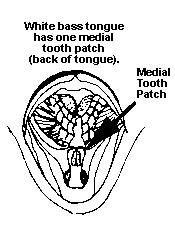Identification of the Temperate Bass
White Bass, Striped Bass, their Hybrid Striped Bass and Yellow Bass





Yellow bass can be identified because they do not have a tooth patch on their tongue and the second spine of the anal fin is longer than the base of the anal fin.
White bass can be identified because they have a single center tooth patch, and their stripes are faint. On a white bass, the first stripe below the lateral line is not distinct nor complete to tail.
Some striped bass may have broken lines, but the stripes of a fresh hybrid are distinct and definitely broken. The shape of the head can be a distinguishing characteristic between the striped bass and the hybrid bass (wiper).
A hybrid bass or "wiper" is shown on above and a striped bass shown below from Lake Jordan on the Coosa River.

White bass (above) and yellow bass (below) were caught in Wilson Reservoir in April of 2007 by Steve Hacker.





